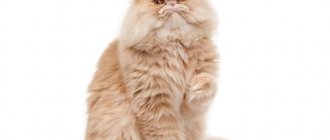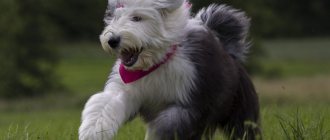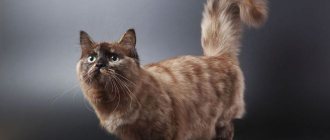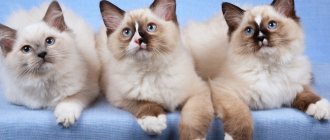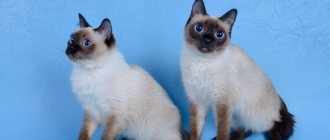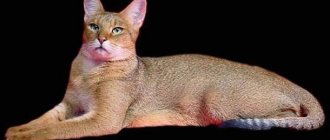A cat capable of conquering with its beauty and sophistication even those who prefer the absolute brutalists of the cat world - measured Britons or independent Scots. The Turkish Angora is beautiful, light, artistic with weightless hair and a piercing gaze, it captivates from the very first moment.
History of the Turkish Angora
Angora cats are one of the oldest breeds today. It appeared in Europe back in the 13th century, and has existed in Turkey since time immemorial.
The Angora is considered a native breed, as it was formed in the wild. It originated from Felis Silvestris Lybica, or steppe cat, and formed on the territory of the Anatolian Peninsula and modern Turkey, later spreading throughout Asia Minor. The first Angoras were brought to Europe as a result of the Crusades, but they became popular only in the 16th century. They were called not only Turkish, but also Persian cats.
Angoras - owners of silk wool without undercoat
Angoras were brought to Russia directly from Turkey after Prince Potemkin’s campaign against Turkey. The aristocracy liked them because they did not strive for street life and were excellent at catching mice. Moreover, it was white cats that were valued. Unfortunately, during the October Revolution, breeding and selection of Angoras was stopped.
There is a legend that white angoras served as napkins for the hands of the Persian Shahs during meals.
In the 19th century, Tibetan and Chinese cats appeared with dense double hair and rounded body shapes. They decided to cross them with Angoras to obtain even longer and silkier wool. These experiments led to the appearance of the Persian cat, so popular in our time. But as a result of these experiments, the breeding of the Angoras themselves stopped. Therefore, in the middle of the twentieth century, the breed practically disappeared.
White Angoras with different eyes are especially prized
Fortunately, there were still a few cats left in the Istanbul Zoo, so in the 60s they were exported to America and Europe to revive the Angoras.
Now only Angoras descended from individuals taken from the Istanbul Zoo are considered purebred.
Based on the fact that their coat type is close to the Oriental, in America they were crossed with long-haired Orientals. The White Angora was registered by the CFA in 1973, and the Color Angora in 1978.
Deafness is common in white Angoras with blue eyes.
In Europe, more precisely in England, Angoras were crossed with Forinwhites (white Orientals with blue eyes) to preserve white fur and blue eyes. As a result, the Americans and the British ended up with rather different cats, and the breed was divided into American and European varieties. But later the varieties were abolished, since their crossing made the cats of the same type.
Continental European countries also tried to cross Angoras with Persians, but it was very rare to achieve the “golden mean” - either the wool did not match the type, or the body was too heavy. However, rare successful individuals were used to increase the gene pool of the breed. The WCF recognized the white version in 1986, the colored one in 1987. The FIFe recognized the white Angora in 1988, and the colored Angora in a limited range in 1994.
The modern Angora cat is a descendant of the Balinese, Foriwhite and the last Angoras from the Istanbul Zoo
Training and education
Many owners of Turkish Angoras boast that their pets are able to carry out certain commands. Perhaps this is so, but still you should not expect too much from a proud and independent animal and treat it like a circus bear. If a cat follows any commands, it perceives it as a game with its beloved owner. As soon as the animal feels that its freedom and dignity are under threat, it will immediately show you “who’s boss.”
The very concept of “training” in relation to a cat walking by itself sounds blasphemous. However, this does not mean at all that there should be no prohibitions for a pet in the house. Not at all, on the contrary, good manners and observance of basic rules of behavior and hygiene are an essential part of “getting along” with a four-legged household member. The minimum that is mandatory for a domestic cat to comply with is the fulfillment of natural needs only in a specially designated place and the point of claws only using a scratching post. The rest, for example, the ban on jumping on the table, is at your discretion.
Breed standard
Currently, the breed is recognized by all major organizations in the world - WCF, CFA, TICA, FIFe, etc.
Angora is a medium-sized cat, weighing from 4 to 7 kg, height about 27–30 cm. Breed standard:
- General Description: The ideal Turkish Angora is a balanced, graceful cat with a fine, silky coat that shimmers as it moves, with a strong, long, muscular body underneath;
- head: small to medium size, in balance with the length of the body and limbs;
- head shape: smooth wedge. Chubby cheeks are allowed;
- profile: two planes formed by the plane of the top of the head and the line of the nose, intersecting slightly above the eyes. The nose line is perfectly smooth, without interruptions;
- muzzle: continuation of the smooth lines of the wedge without noticeable convexity under the whiskers and pinch;
- Ears: large, wide at the base, pointed. Mounted together, high on the head, vertical and tight. There may be tassels;
- eyes: large, almond-shaped, set slightly obliquely with an open expression;
- eye color: can be any shade of green, gold, golden green, copper, blue, or different colors. There is no connection between eye color and coat color. The uniformity and depth of eye color should be taken into account as part of the overall evaluation, with a deeper, richer color being preferred;
- neck: slender, graceful and rather long;
- chin: strong, softly rounded. In profile it forms a perpendicular line with the nose;
- Body: Medium size, however overall balance and grace are more important than actual size. Males can be slightly larger than cats;
- The torso is long and slender. The shoulders are the same width as the hips. The sacrum is slightly higher than the shoulders;
- physique: fine boned with strong muscles. The legs are quite long, the hind legs are longer than the front ones. The paws are small, round and graceful. Tufts of hair between the toes are preferred;
- tail: long and pointed from a wide base to a narrow end, with full pubescence.
- coat: no undercoat. The length of the coat on the body varies, but on the tail and collar it should be long, full, fine in texture and have a silky sheen. The pants should be on the back legs;
- Penalized: obvious excess of size, rough appearance;
- disqualified: stocky body type, kinked or uncorrected tail, squint.
The standards of each organization recognize only the graceful Angora with fine bones, a long neck and silky, shiny coat without undercoat.
Angora cats are not only white
Colors
Each organization accepts almost all colors of Angoras, but white cats are the most valued. There are also prohibited colors:
- faun;
- color-point (acromelanic);
- cinnamon;
- Lilac;
- Himalayan;
- chocolate.
The most common and popular colors of angoras:
- white solid;
- black solid;
- smoky gray;
- blue;
- ticked and marbled tabbies (red, silver, brown, blue, cream);
- cream;
- calico (chintz);
- tortoiseshell - cream and red spots on black. The contours of the spots are clear;
- brindle (mackerel tabby);
- blue-cream - cream spots on blue;
- torby (patchwork tabby);
- bleached chintz;
- bicolors - cream and white, black and white, red and white, blue and white. Only the chest, muzzle, belly and paws should be white. On the face, a white spot in the form of an inverted V is desirable. White under the tail and on the collar is acceptable.
Photo gallery: Angora cat colors
Black Turkish Angoras look beautiful and solid
Blue tabby is rare
Blue Angoras are not known to everyone
Red tabby is lighter than just red
Brown tabby bicolor suggests a V-shaped spot on the face
Blue-cream differs from cream-blue: in it the main color is blue, and in cream-blue it is cream
Calico color is also called calico
Lightened chintz - tri-color color
The brindle tabby color is one of the very first colored colors among angoras.
Angoras have a tortoiseshell color that is only black and red.
Black bicolor is the most common among bicolor colors.
Brown tabby can be either spotted or marbled.
Cream differs from white in a warm shade
Bicolor red marbled tabby is one of the bicolor colors
Thorby seems to be made up of many small pieces
White solid is the most popular color among angoras.
Red brindle is less common than other brindle colors
In marble colors, the pattern is similar to stains in marble
Silver tabby with cream undertone
Coat colors and features
The quality of the coat is of particular importance; Angora cats are characterized by a coat of medium length, completely devoid of undercoat. The hairs are longer on the neck, tail and panties.
The tone of the Turkish Angora fur coat can be monochrome, as well as two or three colors:
- The tortoiseshell combines a black coat with red and cream spots.
- There are 2 options for the smoky color of Angora cats. The Blue Smoke has a white base coat and blue-gray guard hair, while the nose and paw pads remain gray. In another case, the black tint of the nose, paws and cover is combined with a white base of the hairs.
- Wide variety of striped colors. Tabby shades can be blue, cream, marbled, brindle, patchwork, silver, red, brown.
- Solid colors include blue, cream, red, classic white and black angora.
- Bi-color combines a snow-white shade with any of the primary colors or bluish-cream.
- The Calico has a light base with tan and black markings.
- Bleached chintz suggests a white cover with spots of gray and cream.
The coat of a Turkish cat should not be acromelanic, that is, change tone under the influence of temperature.
The following colors or their combination with white are unacceptable for the Angora breed:
- chocolate;
- cinnamon;
- faun;
- lilac;
- Himalayan.
Turkish Angora: cat character
What features are inherent in the Angora cat:
- activity. They run and jump a lot and love to play. Their movements are graceful, watching them is a kind of anti-stress;
- devotion. Angoras are “monogamous” and, as a rule, choose one owner from the whole family. At the same time, they treat others well;
- restlessness. Due to their high activity, these cats cannot sit in one place for more than a minute. That's why they don't like to sit on their hands;
- curiosity. They want to know everything that is happening in the house; they can climb cabinets and tables. Often in the pursuit of “knowledge” one gets into chaos;
Angora chooses one owner, but treats the whole family well - determination and perseverance. If you hide her favorite toy from an angora, she will search for it long and hard. And if he doesn’t find it, he will meow for a long time and demandingly;
- love for water. This feature does not appear in every Angora. But if your cat loves to swim, take the time to give her a bath every couple of weeks. It’s even better if there is a pool or clean pond near the house - Angoras are great lovers of walks;
- dislike of loneliness. If the owner is a busy person, the angora may get bored. Therefore, such cats are taken only into large families or in pairs with another pet;
- Angora treats children quite well, but does not tolerate excessive intrusiveness and causing pain;
- friendly towards other pets, provided there is no aggression on their part. Rodents, fish and birds are prey for her;
- Angoras have a very developed hunting instinct, so the owner should prepare for numerous “surprises” in the form of birds and mice.
Angoras are very active cats
Pros and cons of Turkish Angoras
These interesting pets have both advantages and disadvantages. But they have much more advantages.
Advantages:
- Very smart.
- Interesting appearance.
- Calm character.
- Devotion to the owner.
- Active and playful.
- Love of attention.
- Get along with other animals.
- They treat the arrival of guests calmly.
- Good health.
- They love to walk and swim.
Angoras are loyal to their owner
Flaws:
- Stubbornness.
- Heavy shedding.
- Deafness often occurs.
- Obsessive.
- Recently, the purity of the breed has decreased.
Health
Angoras are the owners of good health and long-livers of the cat world. Typically, representatives of the breed live up to 16–17 years. They are not susceptible to many genetic diseases, but they also have their own risk areas.
Deafness
Occurs in white angoras with one or both blue eyes. Moreover, in mixed-eyed angoras, only the ear located on the side of the blue eye cannot hear, and in blue-eyed ones, both. Hearing loss can be either complete or partial.
Research from Cornell University has shown that 15–22% of white cats with non-blue eyes, 40% of white cats with odd eyes, and 80% of white cats with blue eyes are born deaf. “W” - the white coat gene - determines not only the color of the coat, but also the development of the hearing aid.
An Angora cat develops deafness in the first week of life, so it is not prone to exhibit the symptoms that occur with acquired deafness. But a cat may exhibit the following symptoms:
Deafness in cats is often not noticeable
- lack of reaction to loud noises and sounds in general;
- excessive fearfulness;
- unnaturally loud meowing.
To test your cat's hearing, you can do the following:
- sit close to the cat, preferably so that it does not see you;
- tap your fingers on a hard surface, alternating soft and loud sounds;
- If a cat turns its ears to quiet sounds and its head to loud sounds, then everything is fine with its hearing. If not, you may have hearing problems. But to be sure, the procedure must be repeated 2-3 times after some time.
If a cat has congenital deafness, it cannot be cured.
Ataxia
Ataxia is a complex of problems that lead to impaired coordination of movements. Ataxia can be:
- sensitive - important components of the central nervous system (CNS) are damaged;
- cerebellar - damage to the cerebellum;
- vestibular - damage to the vestibular apparatus.
What else causes ataxia:
- poisoning with substances affecting the nervous system;
- diseases of the central nervous system;
- lack of vitamin B and B1;
- “overdose” of valerian or catnip;
- brain tumor or injury;
- hydrocephalus;
- panleukopenia;
- helminthic infestation.
Video: severe form of ataxia in a kitten
Symptoms of ataxia:
- "drunk" gait;
- unfocused gaze;
- jerky movements;
- joints that do not bend;
- a very cautious gait, with the cat constantly falling over to the left and right;
- The cat moves in zigzags and constantly bumps into walls and furniture.
At the slightest symptoms of ataxia, you need to take your cat to the veterinarian. Only with early diagnosis will there be a chance to get rid of this disease safely.
Hypertrophic cardiomyopathy
A heart disease in which the walls of the heart become stiffer and thicker. As a result, oxygen starvation occurs.
There are several causes of cardiomyopathy:
- age - cats from 7 years of age are more susceptible than “youth”;
- acromegaly - excessive secretion of growth hormone;
- hypertension;
- hyperthyroidism - a disorder of the thyroid gland;
- cancer, in particular lymphoma;
- thoughtless use of medications not prescribed by a veterinarian;
- "bull's heart"
- heredity.
With cardiomyopathy, the walls of the heart thicken.
Symptoms of hypertrophic cardiomyopathy:
- severe shortness of breath;
- pallor of mucous membranes (for example, in the mouth);
- fainting;
- heart murmur;
- arrhythmia.
Cardiomyopathy is extremely difficult to diagnose, so at the slightest suspicion, take your cat to the veterinarian. A properly performed ultrasound examination of the heart will allow us to identify the disease in the early stages and eliminate both it and its causes.
In later stages, the disease is incurable.
Maintenance and care
Due to the fact that the Turkish Angora does not have an undercoat, its coat is single-layered. Therefore, the pet does not develop pellets on its fur and is quite easy to care for. Just weekly brushing is enough. It’s also nice that the Turkish cat is not averse to heavy shedding. The fur reaches its full length only by the age of two years.
Brushing your teeth is a mandatory weekly procedure. This will prevent your pet from developing periodontal disease and other dental problems. Weekly procedures should also include trimming their nails, although some cats wear them down naturally.
Don’t forget about your eyes, the corners of which should be wiped with a damp cloth every week to remove all possible discharge. To prevent possible infection, it is best to use a separate wipe for each eye.
Particular attention is paid to the ears. They should be carefully inspected every week for infections, dirt and irritation. It is best to treat the ears with special wipes moistened with a solution prescribed by a veterinarian. But you can also take a solution of vinegar and water in a 1:1 ratio. Avoid using cotton swabs when cleaning the ear canals.
A clean tray will not only avoid infectious diseases, but will also ensure that there is no unpleasant odor in the house. You must be careful and do not allow your pet to walk on the street unattended. Firstly, you will prevent your pet from having uncontrolled contact with yard animals, and secondly, you will be sure that your pet will not get hit by a car or become a victim of a thief.
Representatives of this breed adore children and especially love to play with them. Therefore, they are perfect for families with small children. It is better not to leave small children unattended. They can pull the animal's fur and hurt it; in turn, the cat can inadvertently scratch the child.
Angoras also get along well with other pets. If you have pets in your home other than the Turkish cat itself, then it is necessary to carry out early socialization and accustom the animals to living together.
Nutrition
The most important thing in nutrition for an Angora cat is balance and the presence of all necessary microelements. You can feed your cat both ready-made food and natural products.
Brands of food for Angora cats
Angora can be fed holistic, premium and super-premium food. Top 5 foods for Angora cats include:
- Carnilove Duck&Turkey Grain&Potato Free. Holistic food, manufacturer - Czech Republic. The food contains only natural products and is produced according to the Grain&Potato Free formula - without grains and potatoes. Main composition: duck fillet - 32%;
- chicken fillet - 32%;
- yellow peas - 16%;
- chicken fat - 11%;
- apples - 6%;
- tapioca extract - 3%;
- chicken giblets - 3%;
- fish oil - 1%;
- carrots - 1%;
- flax seed - 1%.
- lamb - 8%;
- chicken - 18%;
- lamb - 20%;
- chicken fillet;
What food is suitable for kittens:
- Royal Canin Kitten (France, premium);
- Royal Canin Kitten Sterilized (France, premium, for sterilized kittens);
- Orijen Cat&Kitten (USA, premium);
- Acana Grasslands (Canada, holistic);
- 1st Choise Kitten With Chicken (USA, super premium).
Photo gallery: food for Turkish Angora
Canidae Grain Free Pure Elements with Fresh Chicken
Carnilove Duck&Turkey Grain&Potato Free
Acana Grasslands
Orijen Cat&Kitten
Hill's Science Plan Feline Adult Optimal Care with Lamb
Natural nutrition
What can you give an Angora cat:
- meat and offal: lamb, beef, chicken, rabbit, lamb, kidneys, heart and liver. Everything should be boiled or boiled. Share in the diet - 65%;
- porridge - rice, oatmeal, buckwheat. Wheat and corn are not allowed. Share in the diet - 15%;
- all vegetables except onions, garlic and potatoes. They should be ground fresh or boiled into a paste. It is useful to add fresh seaweed to the gruel. Share in the diet - 10%;
- cottage cheese, kefir, natural yogurt, yogurt. The share in the diet is 5–6%; dairy products should be divided into several doses per week;
- quail eggs - 3-4 per week, chicken eggs - 1-2 times. Give raw;
- white boiled sea fish - 2-3 times a week, no more than 20 g at a time.
The daily norm is 140–170 g. The cat is fed 2 times a day with a mixture of 3 parts meat, 1 part vegetable pulp and 2 parts boiled cereal.
You should not give your cat food from the human table, especially sweets and seasonings.
What an Angora cat can’t do:
- canned food;
- pork;
- cheese;
- seasonings;
- economy class food like Kitiket and Whiskas;
- sweets;
- river fish. This is very important, since the substances contained in it destroy vitamin B1, which can lead to the development of ataxia;
- any food from a person's table.
Grooming
The Angora cat's coat has no undercoat and does not tangle, so caring for it is easy:
- first of all, purchase an antistatic spray, a bristle brush, a rubber comb and a combination comb;
- Angora should be combed 3-4 times a week (this is the only way to get rid of long white hairs throughout the house), during the molting period you can do this 5-7 times. Angora cats do not shed as much as other long-haired breeds, but quite a lot. First, the wool is sprayed with an antistatic agent, then combed out first with a rubber comb, then with a bristle brush and a combined comb;
- Washing can be done as soon as the fur becomes dirty. Usually, for white cats, once a month is enough, for cats of other colors - once every month and a half;
- To wash your Angora, you should buy a special shampoo for long-haired cats. It is fashionable to bathe white and black beauties with tinted shampoo - it will make the color brighter and purer. What shampoos are suitable for an Angora cat: Jerob Black-in - for solid black color;
- Jerob Snowy Blue - for white cats;
- Jerob Herbal - suitable for all colors. All Jerob shampoos are concentrated, so they are consumed slowly;
- Bio-Groom Protein-Lanolin Silky Cat Shampoo - contains lanolin and protein, which saturate the coat with essential substances;
- Rolf Club shampoo-conditioner For long-haired breeds;
- Ms. Kiss Luxurious Lioness is a conditioning shampoo for long-haired cats.
Photo gallery: shampoos for angora
Jerob Herbal - concentrated shampoo
Bio-Groom Protein-Lanolin Silky Cat Shampoo with protein and lanolin
Ms. Kiss Luxurious Lioness - affordable shampoo for all cats
Rolf Club shampoo-conditioner is suitable for long-haired cats
Jerob Snowy Blue - suitable for white cats
Jerob Black-in - for black cats
Cleaning teeth, ears, eyes, trimming nails
What you need to care for your cat's ears:
- cotton swabs;
- cat ear cleaning lotion;
- cat ear drops.
Angora ears are cleaned once every 5 days. This is done as follows:
- First, you need to drop drops into the cat’s ear and massage the base of the ear for 1–2 minutes;
- Then wipe the auricle with a cotton swab and lotion.
Tip: If your cat does not participate in shows, trim the brushes in her ears. This will make care easier. But if it does, the brushes need to be wiped every day with a damp cloth and a very weak alcohol solution.
What you need for eye care:
- cat eye care lotion;
- a piece of natural fabric;
- If tear tracks have formed on your face, buy Eye Envy powder.
Eye Envy powder removes tear tracks
Wipe your eyes every day with a cloth with lotion applied to it in the direction from the inner corner to the outer. Tear tracks are treated with powder using a special brush included in the kit. The powder is rubbed into the wool and left for 10 minutes, after which the paths are wiped.
Dental care will require the following supplies:
- silicone toothbrush or special one for cats;
- toothpaste for cats.
The cat's teeth are brushed every 2-3 days. How it's done:
- First, open the cat's mouth by gently pressing on the corners of the mouth.
- Then use a toothbrush and toothpaste to thoroughly brush your teeth, paying attention to all hard-to-reach places.
- You can let your cat chew on your toothbrush - this will clean the teeth even better.
Your cat's teeth need to be kept clean.
To trim your nails you will need a special nail clipper. With it, the likelihood of injuring the cat is minimal. How to trim claws:
- Press down on the pad of the paw until the entire claw is exposed.
- Carefully cut off the transparent part without affecting the pink sensitive part.
- If you do injure your cat's claw, treat the wound with iodine or peroxide.
As an option, you can use special caps on the claws - anti-scratch caps. They are pulled onto the claw and held in place with glue. They do not disrupt the function of the claw: it grows, retracts and extends in the same way, but only if it is put on correctly. The only contraindication: allergy to the glue that is used when putting on the anti-scratch pads. Also, infection can occur under the anti-scratch cap, so it is advisable to change the caps every 1-2 weeks.
Anti-scratch pads do not harm your cat's claws
Breeding Angora cats
Before buying a kitten, a breeder needs to know a lot. Mandatory minimum education: cat genetics courses, felinology courses and minimum veterinary literacy. This is very important - only knowledge will allow you to breed healthy and high-quality representatives of the breed.
The work of a breeder is full of worries:
- first of all, it is necessary to constantly participate in exhibitions and receive titles and markings;
- secondly, selling expensive and purebred kittens is very difficult;
- thirdly, you will have to spend a lot of money on a veterinarian, food, and cat supplies.
The work of a breeder is not easy, but interesting.
But if you are ready for all the difficulties and have all the necessary knowledge, then you can choose a cat. There are some things to keep in mind:
- It is better for a novice breeder to purchase a cat or a breeding pair immediately;
- animals should be chosen show or breeding class;
- there should be no deaf ancestors in the pedigree of the Angora cat, and the kitten itself must be healthy;
- Be sure to choose cats from a good cattery with all the documents;
- When purchasing, a sales contract is drawn up, which stipulates that the breeder agrees to give the cats for breeding. With the kitten, you must receive its pedigree or birth certificate and veterinary passport.
As soon as you have purchased cats, you must register your cattery and its producers. To do this, you need to contact the breed club or the club of the felinological organization in which the breed is recognized. There you will be given the necessary documents and registration, which will include the name of the club, the number of breeding sires and other necessary information. If you wish, you can also register a nursery seal with the club.
It is very important that partners are compatible by blood type
If you decide to spay or neuter your pet, the optimal age for this is 6-7 months.
The next step will be an exhibition where the club's manufacturers need to be presented. There, the cat must receive a rating of at least “very good”, valid for a year, and the cat must receive a rating of at least “excellent”, valid for a year. If desired and possible, the animal can close the title and receive a title certificate, which is valid for life.
After this, you can start looking for a partner. It is better to do this at exhibitions and among nurseries that provide cats for mating. Online platforms and advertisements are not suitable, since you rarely see truly purebred animals there.
Criteria for choosing a partner:
- full compliance with the standard;
- availability of a confirmed pedigree, veterinary passport and a valid divorce appraisal or title certificate;
- if your cat is mating for the first time, then the cat should not be mating for the first time;
- the cat should not be younger than 1 - 1.5 years. The female also mates for the first time no earlier than 1.5 years;
- blood group compatibility. You can find this out from your veterinarian. Compatibility scheme: female of group A - males of groups A and B;
- female of group B - males of group B;
- male of group A - female of group A;
- male of group B - females of groups A and B.
As soon as a suitable partner is found, you need to contact the club where your nursery is registered and get a referral for mating, written down on a special form. If you have two cats, you need to do this for both. The partner must also have a referral from his club.
To breed cats you need to get directions from the club
Mating always takes place on the cat's territory. You need to prepare for mating in advance:
- draw up an agreement stipulating re-mating in case the first one is unsuccessful and payment - in a kitten or in cash;
- transport the cat's belongings to the cat's territory: bowls, a supply of food for 3-4 days, a bed and a scratching post. The cat's owners must provide a separate safe room for mating;
- trim the cat’s claws - she may scratch the cat during his “persuasion”;
- wait for the heat and take the cat to the cat for 2-3 days.
How to understand that a cat is pregnant:
- sudden cessation of estrus at an uncharacteristic time for the cat;
- changes in the cat’s character and habits;
- a month after estrus, the cat’s stomach noticeably enlarges;
- nipples swell and turn pink starting from the third week, at which time vomiting appears in the morning;
- the cat's appetite increases;
- From the third week, the cat can be taken for an ultrasound. If she does not become pregnant, the mating must be repeated during the next heat.
History of the breed in Russia
It is generally accepted that the first Angoras to appear in Russia were cats brought as a gift to Catherine II by Prince Potemkin-Tauride. The exotic gift came from the Crimean campaign, or more precisely, the Russian-Turkish War of 1768-1774, in which many statesmen of that time distinguished themselves, including the empress’s favorite.
This is interesting! Maintaining her reputation as an enlightened empress, Catherine was actively involved in the formation of art collections of the Hermitage. The Empress did not like cats too much, preferring dogs to them.
But realizing the damage mice could cause to a precious collection of paintings, she let cats into the halls of the palace to fight rodents . Angoras also served in the royal palaces; their appearance most closely matched the luxurious interiors of the Winter Palace. Today, the famous Hermitage cats continue this tradition, protecting the cultural heritage of Russia from attacks by rats and mice.
From the chambers of crowned persons, Angoras gradually moved to the boudoirs of noble ladies and merchants' living rooms, but they still remained expensive cats, the maintenance of which only wealthy people could afford. Only at the end of the 19th century. snow-white beauties became a “democratic” breed, living in the homes of representatives of less wealthy classes.
Thanks to their exceptional decorative qualities, angoras in Russia were extremely popular and loved. At the turn of the 19th and 20th centuries, when the first cat exhibitions began to be organized in the country, they were almost the only participants in these events.
Years of revolutionary chaos and the difficult trials of the Great Patriotic War led to the cessation of Angora cat breeding activities. And only in the 1980s they again attracted the attention of Russian breeders. Unlike other countries, Angoras in Russia were not used to improve the phenotype of other long-haired breeds. Today, specialized nurseries are actively working to breed purebred Angora cats of the highest class.
Return to content
How to choose a Turkish Angora
Before choosing a kitten, decide on the purpose: why you need it. After that, select a class:
- Show. The best cats, fully complying with the standard. They are used in exhibition careers and for breeding. The price for a show-class Turkish Angora is from 30,000 rubles;
- Breed. Suitable for breeding, does not participate in exhibitions. Usually such cats have a minor flaw that does not allow them to become a champion at the show. The price for such a cat is 20,000 -30,000 rubles.
- Pet. A domestic pet cat that has a defect that prevents it from becoming a breeder or a champion at a show. Angora dogs with hearing impairment usually fall into this category. The price for such cats is from 10,000 to 20,000 rubles.
Deaf Angoras as pets are no worse than hearing ones: they are just as active, playful and loyal, and do not experience discomfort from their disadvantage.
How to choose a Turkish Angora kitten:
- First of all, you need to choose not a kitten, but a nursery. He must be authoritative, his cats must have awards from exhibitions. A good nursery is the key to a successful choice of a kitten. Remember also that a responsible breeder will not give away kittens under 3-6 months of age;
- Upon arrival at the nursery, first examine the kittens. If you wish, you can request all the necessary documents: pedigree or birth certificate, breeding list;
- Be sure to examine the kittens' parents and ask for their pedigrees. They must meet the standard. Kittens always look like their parents, this will help you choose the right kitten;
- It is easy to distinguish an Angora kitten from a Balinese (oriental long-haired) and a Forinwhite: Angoras have long hair from childhood, while Forins and Balinese are born short-haired and acquire a long coat by the age of one year;
- Also, the structure of the fur of Angoras and their distant relatives is different: in Turkish beauties it is more close-fitting and silky, there is not even a hint of undercoat, the collar and panties are thicker, and the ears are set much closer and higher, decorated with small tassels. Balinese and Foreign cats have less silky hair, no pants or collars or they are poorly defined, and their ears are set low;
Sometimes unscrupulous people can pass off Forinwhites and Balinese as Angoras, but they are easy to distinguish
Choosing a kitten and cost
It is best to purchase from nurseries, which are located in all major cities of Russia, or from a breeder with good recommendations. You should pick up a cat no earlier than 1.5 months (the optimal age for moving to a new home is 2.5-3 months). From 1.5 months it is already possible to determine how well the animal hears.
The kitten should be active, playful, with clear eyes, ears and a soft tummy. An elastic, tense abdomen indicates a possible helminthic infestation. Prices for kittens depend on the class and color, but in general they are low: from 5 to 15 thousand rubles.
Photo gallery of Turkish Angoras:
1111

